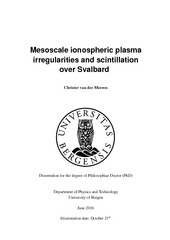| dc.contributor.author | van der Meeren, Christer | |
| dc.date.accessioned | 2016-10-13T09:23:26Z | |
| dc.date.available | 2016-10-13T09:23:26Z | |
| dc.date.issued | 2016-10-21 | |
| dc.identifier.uri | https://hdl.handle.net/1956/12991 | |
| dc.description.abstract | This thesis investigates how navigation signals are compromised by ionospheric plasma irregularities in the auroral and polar ionosphere over Svalbard. In 2013, four multiconstellation global navigation satellite system (GNSS) receivers were installed in NyÅlesund, Longyearbyen, Hopen, and Bjørnøya. These receivers provide unprecedented coverage of scintillation and plasma density (total electron content) in the region. The four research papers in this thesis are detailed case studies investigating mesoscale irregularities and scintillation.We use data from these GNSS receivers, all-sky imagers, coherent and incoherent scatter radars, ionosondes, and in-situ satellite measurements. Paper I [van der Meeren et al., 2014] investigates scintillation and irregularities on the front of a tongue of ionization (TOI) in the polar cap. Moderate scintillation and structuring is observed on the leading edge of the TOI. We employ a novel method where we use spectrograms of the phase of raw GNSS signals to show that the structuring is real and not due to erroneous data detrending of the σφ phase scintillation index. Paper II [Oksavik et al., 2015] investigates irregularities in the dayside auroral region, specifically in relation to poleward-moving auroral forms (PMAFs). Scintillation is strongly localized to these intense and transient features, even in the presence of polar cap patches. Paper III [van der Meeren et al., 2015] investigates scintillation from substorm auroral emissions as polar cap patches enter the nightside auroral oval. The most severe scintillation is found when the auroral precipitation coincides with polar cap patches. The scintillation is strongly localized to signals intersecting intense auroral emissions. Paper IV [van der Meeren et al., 2016] investigates irregularities during quiet geomagnetic conditions. We find weak irregularities in relation to a stable and intense transpolar arc, but no scintillation is seen. The main results in this thesis are: <ul> Scintillation-producing irregularities can exist on the leading edge of TOIs, in PMAFs, and in substorm auroral precipitation when patches enter the nightside auroral oval. Of these, auroral precipitation on top of pre-existing plasma patches seems to produce the strongest scintillation. The scintillation generally shows a high degree of localization, varying significantly over distances of ∼ 100km. This clearly indicates the need for a dense network of scintillation receivers in the polar ionosphere to fully resolve this spatial variation. It also shows that detailed case studies are important to complement the averaged, static, large-scale picture common in statistical studies. We have developed a novel method of using spectrograms of the phase of raw GNSS signals to get a more complete view of irregularities than aggregate scintillation indices like σφ . Furthermore, our method does not require data detrending, and it is therefore more robust than traditional scintillation indices that are frequently used by the community. The observed irregularities cover a wide range of spatial scale sizes, from decameters to several kilometers. Irregularities at these spatial scale sizes can affect radio wave propagation from HF to GNSS frequencies. </ul> | en_US |
| dc.language.iso | eng | eng |
| dc.publisher | The University of Bergen | en_US |
| dc.relation.haspart | Paper I: van der Meeren, C., K. Oksavik, D. Lorentzen, J. I. Moen, and V. Romano, GPS scintillation and irregularities at the front of an ionization tongue in the nightside polar ionosphere, Journal of Geophysical Research: Space Physics, 119(10), 8624–8636, doi:10.1002/2014JA020114, 2014. The article is available at: <a href="http://hdl.handle.net/1956/9681" target="blank">http://hdl.handle.net/1956/9681</a> | en_US |
| dc.relation.haspart | Paper II: Oksavik, K., C. van der Meeren, D. A. Lorentzen, L. J. Baddeley, and J. Moen, Scintillation and loss of signal lock from poleward moving auroral forms in the cusp ionosphere, Journal of Geophysical Research: Space Physics, 120(10), doi:10.1002/2015JA021528, 2015. The article is available at: <a href="http://hdl.handle.net/1956/11844" target="blank">http://hdl.handle.net/1956/11844</a> | en_US |
| dc.relation.haspart | Paper III: van der Meeren, C., K. Oksavik, D. A. Lorentzen, M. T. Rietveld, and L. B. N. Clausen, Severe and localized GNSS scintillation at the poleward edge of the nightside auroral oval during intense substorm aurora, Journal of Geophysical Research: Space Physics, 120(12), doi:10.1002/2015JA021819, 2015. The article is available at: <a href="http://hdl.handle.net/1956/12989" target="blank">http://hdl.handle.net/1956/12989</a> | en_US |
| dc.relation.haspart | Paper IV: van der Meeren, C., K. Oksavik, D. A. Lorentzen, L. J. Paxton, and L. B. N. Clausen, Scintillation and irregularities from the nightside part of a sun-aligned polar cap arc, Journal of Geophysical Research: Space Physics, 121, doi:10.1002/2016JA022708, 2016. The article is available at: <a href="http://hdl.handle.net/1956/12990" target="blank">http://hdl.handle.net/1956/12990</a> | en_US |
| dc.title | Mesoscale ionospheric plasma irregularities and scintillation over Svalbard | en_US |
| dc.type | Doctoral thesis | |
| dc.rights.holder | Copyright the author. All rights reserved | en_US |
| dc.identifier.cristin | 1390983 | |
| dc.subject.nsi | VDP::Matematikk og Naturvitenskap: 400::Fysikk: 430::Rom- og plasmafysikk: 437 | en_US |
